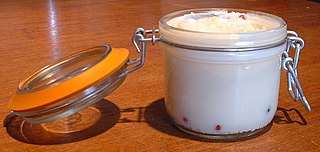
Paraffin wax is a soft colorless solid derived from petroleum, coal, or oil shale that consists of a mixture of hydrocarbon molecules containing between 20 and 40 carbon atoms. It is solid at room temperature and begins to melt above approximately 37 °C (99 °F), and its boiling point is above 370 °C (698 °F). Common applications for paraffin wax include lubrication, electrical insulation, and candles; dyed paraffin wax can be made into crayons. It is distinct from kerosene and other petroleum products that are sometimes called paraffin.

Beeswax is a natural wax produced by honey bees of the genus Apis. The wax is formed into scales by eight wax-producing glands in the abdominal segments of worker bees, which discard it in or at the hive. The hive workers collect and use it to form cells for honey storage and larval and pupal protection within the beehive. Chemically, beeswax consists mainly of esters of fatty acids and various long-chain alcohols.

A candle is an ignitable wick embedded in wax, or another flammable solid substance such as tallow, that provides light, and in some cases, a fragrance. A candle can also provide heat or a method of keeping time.

Waxes are a diverse class of organic compounds that are lipophilic, malleable solids near ambient temperatures. They include higher alkanes and lipids, typically with melting points above about 40 °C (104 °F), melting to give low viscosity liquids. Waxes are insoluble in water but soluble in nonpolar organic solvents such as hexane, benzene and chloroform. Natural waxes of different types are produced by plants and animals and occur in petroleum.

Tallow is a rendered form of beef or mutton suet, primarily made up of triglycerides.

Myrica gale is a species of flowering plant in the family Myricaceae, native to parts of Japan, North Korea, Russia, mainland Europe, the British Isles and parts of northern North America, in Canada and the United States. Common names include bog-myrtle, sweet willow, Dutch myrtle, and sweetgale.

Myrica is a genus of about 35–50 species of small trees and shrubs in the family Myricaceae, order Fagales. The genus has a wide distribution, including Africa, Asia, Europe, North America and South America, and missing only from Australia. Some botanists split the genus into two genera on the basis of the catkin and fruit structure, restricting Myrica to a few species, and treating the others in Morella.

Myrica rubra, also called yangmei, yamamomo, Chinese bayberry, red bayberry, yumberry, waxberry, or Chinese strawberry is a subtropical tree grown for its fruit.

Myrica californica is an evergreen shrub or small tree native to the Pacific Ocean coast of North America from Vancouver Island south to California as far south as the Long Beach area.
Japan wax, also known as sumac wax, sumach wax, vegetable wax, China green tallow, and Japan tallow, is a pale-yellow, waxy, water-insoluble solid with a gummy feel, obtained from the berries of certain sumacs native to Japan and China, such as Toxicodendron vernicifluum and Toxicodendron succedaneum.

Myrica pensylvanica, the northern bayberry, is a species of Myrica native to eastern North America, from Newfoundland west to Ontario and Ohio, and south to North Carolina. It is also classified as Morella pensylvanica.

Myrica cerifera is a small evergreen tree or large shrub native to North and Central America and the Caribbean. Its common names include southern wax myrtle, southern bayberry, candleberry, bayberry tree, and tallow shrub. It has uses in the garden and for candlemaking, as well as a medicinal plant.

Myricitrin is a plant compound, the 3-O-α-L-rhamnopyranoside of myricetin.

Catocala badia, the bay underwing, bayberry underwing or old maid, is a moth of the family Erebidae. It is found from southern Maine and New Hampshire south to New York and Connecticut.
Strepsicrates smithiana, the bayberry leaftier moth or Smith's strepsicrates moth, is a moth of the family Tortricidae. It was first described by Lord Walsingham in 1891. It is native to southern North America, south to South America, including Florida, Texas, Georgia, Dominican Republic, Puerto Rico, Cuba and the Galapagos Islands. It was introduced to Oahu, Hawaii, in 1955 to aid in the control of Myrica faya.

Myrica esculenta is an tree or large shrub of the tropics. The native range of this species stretches from Nepal to southern China and western & central Malesia. It's common names include box myrtle, bayberry and kaphal. Its berries are edible and are consumed locally.
The southern coastal plain nonriverine cypress dome is a forested wetland community found in the southern Atlantic coastal plain, in the states of Alabama, Florida, Georgia, Louisiana, and Mississippi.

Myrica inodora is a plant species native to the coastal plains on the northern shore of the Gulf of Mexico, in the Florida Panhandle, the extreme southern parts of Alabama and Mississippi, eastern Louisiana and southwestern Georgia. Common names include scentless bayberry, odorless bayberry, odorless wax-myrtle, waxberry, candleberry, and waxtree. It grows in swamps, bogs, pond edges and stream banks.

Myrica caroliniensis is a shrub or small tree native to the coast and coastal plains of southeastern North America. Its common names include bayberry, southern bayberry, pocosin bayberry, and evergreen bayberry. It sees uses in the garden and for candlemaking, as well as a medicinal plant.
Colaspis pseudofavosa is a species of leaf beetle from North America. It is a post-harvest pest of blueberries in the southeastern United States, and also feeds on plants such as southern wax myrtles and pecans.














